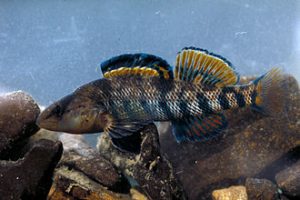Rainbow Pride
In the early 1840s the Fox River was the site of an important icthyological discovery of which we should all be proud. A Mr. S.C. Clark collected a small, nondescript female fish from the river and preserved it for scientific study. The fish was unfamiliar to the Illinois State Biologists and ended up in the Massachusetts laboratory of noted taxonomist David Humphreys Storer. In 1845, Storer officially entered the Rainbow Darter (Etheostoma caeruleum) in the scientific literature. Yay!
She’s Like A Rainbow, He Comes in Colors Everywhere!
The female rainbow darter is a handsome blend of orange, brown and green. Her cryptic coloration lets her safely slide through the gravelly shallows of her fast flowing habitat. The male is more colorful and provides the species with its name. During the spring breeding season, the male turns bright orange with vivid blue bands and stripes.
Rainbow darters are Midwestern fish. Very sensitive to pollution, they’re found in clean rivers and creeks that flow through wooded lands, not prairies. Their required habitat – clear, swift flowing riffles with crustaceans and insects to eat – is rare in the Fox River itself. These fish cannot tolerate muck and silt on the bottom and have suffered from 150 years of human activity.
Undaunted Darters
 Despite the dams, acres of roofs, and square miles of subdivisions covering the watershed, rainbow darters are still found in some tributaries of the Fox River. Last June, 180 years after Mr. Clark plucked the first darter science had seen out of our river, one of its descendants was found in Tyler Creek.
Despite the dams, acres of roofs, and square miles of subdivisions covering the watershed, rainbow darters are still found in some tributaries of the Fox River. Last June, 180 years after Mr. Clark plucked the first darter science had seen out of our river, one of its descendants was found in Tyler Creek.
And that first rainbow darter? She’s still with us! She is currently residing in Cambridge, Massachusetts, as the holotype specimen in the Museum of Comparative Zoology at Harvard University.

